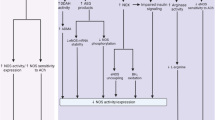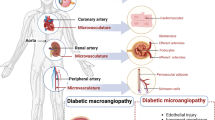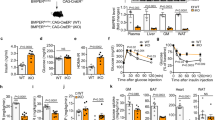Abstract
Endothelial dysfunction is one manifestation of the many changes induced in the arterial wall by the metabolic abnormalities accompanying diabetes and insulin resistance. In type 1 diabetes, endothelial dysfunction is most consistently found in advanced stages of the disease. In other patients, it is associated with nondiabetic insulin resistance and probably precedes type 2 diabetes. In obesity and insulin resistance, increased secretion of proinflammatory cytokines and decreased secretion of adiponectin from adipose tissue, increased circulating levels of free fatty acids, and postprandial hyperglycemia can all alter gene expression and cell signaling in vascular endothelium, cause vascular insulin resistance, and change the release of endothelium-derived factors. In diabetes, sustained hyperglycemia causes increased intracellular concentrations of glucose metabolites in endothelial cells. These changes cause mitochondrial dysfunction, increased oxidative stress, and activation of protein kinase C. Dysfunctional endothelium displays activation of vascular NADPH oxidase, uncoupling of endothelial nitric oxide synthase, increased expression of endothelin 1, a changed balance between the production of vasodilator and vasoconstrictor prostanoids, and induction of adhesion molecules. This review describes how these and other changes influence endothelium-dependent vasodilation in patients with insulin resistance and diabetes. The clinical utility of endothelial function testing and future therapeutic targets is also discussed.
Key Points
-
Endothelial vasomotor function is mediated by factors secreted from vascular endothelial cells, including nitric oxide, prostacyclin, endothelin 1, thromboxane, and other molecules
-
Insulin resistance and diabetes are characterized by endothelial dysfunction, with decreased production of vasodilatory factors and increased production of vasoconstricting factors
-
Changes in cellular signaling and secreted factors, among them vasomotor factors, contribute to an increased risk of vasothrombotic complications in diabetes
-
Atherosclerotic complications can be prevented by interfering with endothelial cell signaling and endothelium-derived factors
-
Endothelial function can be measured noninvasively in patients and future research might allow such testing to predict the efficacy of drug and lifestyle interventions
This is a preview of subscription content, access via your institution
Access options
Subscribe to this journal
Receive 12 print issues and online access
$209.00 per year
only $17.42 per issue
Buy this article
- Purchase on Springer Link
- Instant access to full article PDF
Prices may be subject to local taxes which are calculated during checkout

Similar content being viewed by others
References
Brunner H et al. (2005) Endothelial function and dysfunction. Part II: association with cardiovascular risk factors and diseases. A statement by the Working Group on Endothelins and Endothelial Factors of the European Society of Hypertension. J Hypertens 23: 233–246
Kuhlencordt PJ et al. (2001) Accelerated atherosclerosis, aortic aneurysm formation, and ischemic heart disease in apolipoprotein E/endothelial nitric oxide synthase double-knockout mice. Circulation 104: 448–454
Barton M et al. (1998) Endothelin ETA receptor blockade restores NO-mediated endothelial function and inhibits atherosclerosis in apolipoprotein E-deficient mice. Proc Natl Acad Sci USA 95: 14367–14372
Kobayashi T et al. (2004) Roles of thromboxane A2 and prostacyclin in the development of atherosclerosis in apoE-deficient mice. J Clin Invest 114: 784–794
Furchgott RF and Zawadzki JV (1980) The obligatory role of endothelial cells in the relaxation of arterial smooth muscle by acetylcholine. Nature 288: 373–376
Vallance P et al. (1989) Effects of endothelium-derived nitric oxide on peripheral arteriolar tone in man. Lancet 2: 997–1000
Corretti MC et al. (2002) Guidelines for the ultrasound assessment of endothelial-dependent flow-mediated vasodilation of the brachial artery: a report of the International Brachial Artery Reactivity Task Force. J Am Coll Cardiol 39: 257–265
Calver A et al. (1992) Inhibition and stimulation of nitric oxide synthesis in the human forearm arterial bed of patients with insulin-dependent diabetes. J Clin Invest 90: 2548–2554
De Vriese AS et al. (2000) Endothelial dysfunction in diabetes. Br J Pharmacol 130: 963–974
McVeigh GE et al. (1992) Impaired endothelium-dependent and independent vasodilation in patients with type 2 (non-insulin-dependent) diabetes mellitus. Diabetologia 35: 771–776
Steinberg HO et al. (1996) Obesity/insulin resistance is associated with endothelial dysfunction. Implications for the syndrome of insulin resistance. J Clin Invest 97: 2601–2610
Beckman JA et al. (2002) Inhibition of protein kinase Cβ prevents impaired endothelium-dependent vasodilation caused by hyperglycemia in humans. Circ Res 90: 107–111
Hink U et al. (2001) Mechanisms underlying endothelial dysfunction in diabetes mellitus. Circ Res 88: E14–E22
Zou MH et al. (2004) Peroxynitrite and vascular endothelial dysfunction in diabetes mellitus. Endothelium 11: 89–97
Cosentino F et al. (2003) High glucose causes upregulation of cyclooxygenase-2 and alters prostanoid profile in human endothelial cells: role of protein kinase C and reactive oxygen species. Circulation 107: 1017–1023
Cardillo C et al. (2002) Increased activity of endogenous endothelin in patients with type II diabetes mellitus. Circulation 106: 1783–1787
Makimattila S et al. (1997) Hyperreactivity to nitrovasodilators in forearm vasculature is related to autonomic dysfunction in insulin-dependent diabetes mellitus. Circulation 95: 618–625
Suwaidi JA et al. (2000) Long-term follow-up of patients with mild coronary artery disease and endothelial dysfunction. Circulation 101: 948–954
Modena MG et al. (2002) Prognostic role of reversible endothelial dysfunction in hypertensive postmenopausal women. J Am Coll Cardiol 40: 505–510
Beishuizen ED et al. (2005) The effect of statin therapy on endothelial function in type 2 diabetes without manifest cardiovascular disease. Diabetes Care 28: 1668–1674
Fleming I and Busse R (2003) Molecular mechanisms involved in the regulation of the endothelial nitric oxide synthase. Am J Physiol Regul Integr Comp Physiol 284: R1–R12
Yamamoto K et al. (2006) Impaired flow-dependent control of vascular tone and remodeling in P2X4-deficient mice. Nat Med 12: 133–137
Tzima E et al. (2005) A mechanosensory complex that mediates the endothelial cell response to fluid shear stress. Nature 437: 426–431
Cai H and Harrison DG (2000) Endothelial dysfunction in cardiovascular diseases: the role of oxidant stress. Circ Res 87: 840–844
Laursen JB et al. (2001) Endothelial regulation of vasomotion in apoE-deficient mice: implications for interactions between peroxynitrite and tetrahydrobiopterin. Circulation 103: 1282–1288
Shinozaki K et al. (2000) Oral administration of tetrahydrobiopterin prevents endothelial dysfunction and vascular oxidative stress in the aortas of insulin-resistant rats. Circ Res 87: 566–573
Heitzer T et al. (2000) Tetrahydrobiopterin improves endothelium-dependent vasodilation by increasing nitric oxide activity in patients with type II diabetes mellitus. Diabetologia 43: 1435–1438
Channon KM (2004) Tetrahydrobiopterin: regulator of endothelial nitric oxide synthase in vascular disease. Trends Cardiovasc Med 14: 323–327
Ding Y et al. (2000) Effects of simulated hyperglycemia, insulin, and glucagon on endothelial nitric oxide synthase expression. Am J Physiol Endocrinol Metab 279: E11–E17
Kuboki K et al. (2000) Regulation of endothelial constitutive nitric oxide synthase gene expression in endothelial cells and in vivo: a specific vascular action of insulin. Circulation 101: 676–681
Naruse K et al. (2006) Activation of vascular PKC-β inhibits Akt-dependent endothelial nitric oxide synthase function in obesity-associated insulin resistance. Diabetes 55: 691–698
Park JY et al. (2000) Induction of endothelin-1 expression by glucose: an effect of protein kinase C activation. Diabetes 49: 1239–1248
Oliver FJ et al. (1991) Stimulation of endothelin-1 gene expression by insulin in endothelial cells. J Biol Chem 266: 23251–23256
Cardillo C et al. (1999) Insulin stimulates both endothelin and nitric oxide activity in the human forearm. Circulation 100: 820–825
Rask-Madsen C and King GL (2005) Proatherosclerotic mechanisms involving protein kinase C in diabetes and insulin resistance. Arterioscler Thromb Vasc Biol 25: 487–496
Rask-Madsen C et al. (2001) Insulin therapy improves insulin-stimulated endothelial function in patients with type 2 diabetes and ischemic heart disease. Diabetes 50: 2611–2618
Montagnani M et al. (2001) Insulin-stimulated activation of eNOS is independent of Ca2+ but requires phosphorylation by Akt at Ser(1179). J Biol Chem 276: 30392–30398
Federici M et al. (2004) G972R IRS-1 variant impairs insulin regulation of endothelial nitric oxide synthase in cultured human endothelial cells. Circulation 109: 399–405
Vicent D et al. (2003) The role of endothelial insulin signaling in the regulation of vascular tone and insulin resistance. J Clin Invest 111: 1373–1380
Jiang ZY et al. (1999) Characterization of selective resistance to insulin signaling in the vasculature of obese Zucker (fa/fa) rats. J Clin Invest 104: 447–457
Cusi K et al. (2000) Insulin resistance differentially affects the PI 3-kinase- and MAP kinase-mediated signaling in human muscle. J Clin Invest 105: 311–320
He Z et al. (2006) Regulation of vascular endothelial growth factor expression and vascularization in the myocardium by insulin receptor and PI3K/Akt pathways in insulin resistance and ischemia. Arterioscler Thromb Vasc Biol 26: 787–793
Folli F et al. (1997) Angiotensin II inhibits insulin signaling in aortic smooth muscle cells at multiple levels. J Clin Invest 100: 2158–2169
Federici M et al. (2002) Insulin-dependent activation of endothelial nitric oxide synthase is impaired by O-linked glycosylation modification of signaling proteins in human coronary endothelial cells. Circulation 106: 466–472
Du XL et al. (2001) Hyperglycemia inhibits endothelial nitric oxide synthase activity by posttranslational modification at the Akt site. J Clin Invest 108: 1341–1348
Arcaro G et al. (2002) Insulin causes endothelial dysfunction in humans: sites and mechanisms. Circulation 105: 576–582
Montagnani M et al. (2002) Inhibition of phosphatidylinositol 3-kinase enhances mitogenic actions of insulin in endothelial cells. J Biol Chem 277: 1794–1799
Wellen KE and Hotamisligil GS (2005) Inflammation, stress, and diabetes. J Clin Invest 115: 1111–1119
Kim F et al. (2005) Free fatty acid impairment of nitric oxide production in endothelial cells is mediated by IKKβ. Arterioscler Thromb Vasc Biol 25: 989–994
Hingorani AD et al. (2000) Acute systemic inflammation impairs endothelium-dependent dilatation in humans. Circulation 102: 994–999
Kim F et al. (2001) TNF-α inhibits flow and insulin signaling leading to NO production in aortic endothelial cells. Am J Physiol Cell Physiol 280: C1057–C1065
Rask-Madsen C et al. (2003) Tumor necrosis factor-α inhibits insulin's stimulating effect on glucose uptake and endothelium-dependent vasodilation in humans. Circulation 108: 1815–1821
Federici M et al. (2005) Timp3 deficiency in insulin receptor-haploinsufficient mice promotes diabetes and vascular inflammation via increased TNF-α. J Clin Invest 115: 3494–3505
Branen L et al. (2004) Inhibition of tumor necrosis factor-α reduces atherosclerosis in apolipoprotein E knockout mice. Arterioscler Thromb Vasc Biol 24: 2137–2142
Shen YH et al. (2006) Up-regulation of PTEN (phosphatase and tensin homolog deleted on chromosome ten) mediates p38 MAPK stress signal-induced inhibition of insulin signaling. A cross-talk between stress signaling and insulin signaling in resistin-treated human endothelial cells. J Biol Chem 281: 7727–7736
Hug C and Lodish HF (2005) The role of the adipocyte hormone adiponectin in cardiovascular disease. Curr Opin Pharmacol 5: 129–134
Kaiser N et al. (1993) Differential regulation of glucose transport and transporters by glucose in vascular endothelial and smooth muscle cells. Diabetes 42: 80–89
Giardino I et al. (1994) Nonenzymatic glycosylation in vitro and in bovine endothelial cells alters basic fibroblast growth factor activity. A model for intracellular glycosylation in diabetes. J Clin Invest 94: 110–117
Steinberg HO et al. (1997) Elevated circulating free fatty acid levels impair endothelium-dependent vasodilation. J Clin Invest 100: 1230–1239
Ceriello A et al. (2002) Evidence for an independent and cumulative effect of postprandial hypertriglyceridemia and hyperglycemia on endothelial dysfunction and oxidative stress generation: effects of short- and long-term simvastatin treatment. Circulation 106: 1211–1218
Inoguchi T et al. (2000) High glucose level and free fatty acid stimulate reactive oxygen species production through protein kinase C-dependent activation of NAD(P)H oxidase in cultured vascular cells. Diabetes 49: 1939–1945
Du X et al. (2003) Inhibition of GAPDH activity by poly(ADP-ribose) polymerase activates three major pathways of hyperglycemic damage in endothelial cells. J Clin Invest 112: 1049–1057
Brownlee M (2001) Biochemistry and molecular cell biology of diabetic complications. Nature 414: 813–820
Inoguchi T et al. (1992) Preferential elevation of protein kinase C isoform β II and diacylglycerol levels in the aorta and heart of diabetic rats: differential reversibility to glycemic control by islet cell transplantation. Proc Natl Acad Sci USA 89: 11059–11063
Igarashi M et al. (1999) Glucose or diabetes activates p38 mitogen-activated protein kinase via different pathways. J Clin Invest 103: 185–195
Ishii H et al. (1996) Amelioration of vascular dysfunctions in diabetic rats by an oral PKC β inhibitor. Science 272: 728–731
Andrassy M et al. (2005) Central role of PKCβ in neointimal expansion triggered by acute arterial injury. Circ Res 96: 476–483
Leitges M et al. (2001) Exacerbated vein graft arteriosclerosis in protein kinase Cδ-null mice. J Clin Invest 108: 1505–1512
Ting HH et al. (1996) Vitamin C improves endothelium-dependent vasodilation in patients with non-insulin-dependent diabetes mellitus. J Clin Invest 97: 22–28
Griendling KK and FitzGerald GA (2003) Oxidative stress and cardiovascular injury: part II: animal and human studies. Circulation 108: 2034–2040
Wu L et al. (2004) Dietary approach to attenuate oxidative stress, hypertension, and inflammation in the cardiovascular system. Proc Natl Acad Sci USA 101: 7094–7099
Lassegue B and Clempus RE (2003) Vascular NAD(P)H oxidases: specific features, expression, and regulation. Am J Physiol Regul Integr Comp Physiol 285: R277–R297
Mollnau H et al. (2002) Effects of angiotensin II infusion on the expression and function of NAD(P)H oxidase and components of nitric oxide/cGMP signaling. Circ Res 90: E58–E65
Guzik TJ et al. (2002) Mechanisms of increased vascular superoxide production in human diabetes mellitus: role of NAD(P)H oxidase and endothelial nitric oxide synthase. Circulation 105: 1656–1662
Bernal-Mizrachi C et al. (2005) Vascular respiratory uncoupling increases blood pressure and atherosclerosis. Nature 435: 502–506
Wisloff U et al. (2005) Cardiovascular risk factors emerge after artificial selection for low aerobic capacity. Science 307: 418–420
Nisoli E et al. (2005) Calorie restriction promotes mitochondrial biogenesis by inducing the expression of eNOS. Science 310: 314–317
Garcia Soriano F et al. (2001) Diabetic endothelial dysfunction: the role of poly(ADP-ribose) polymerase activation. Nat Med 7: 108–113
Basta G et al. (2004) Advanced glycation end products and vascular inflammation: implications for accelerated atherosclerosis in diabetes. Cardiovasc Res 63: 582–592
Acknowledgements
A Mentor-Based Postdoctoral Fellowship Award to GL King from the American Diabetes Association (7-02-MN-12) supports C Rask-Madsen. This work is also supported by grants from the National Institutes of Health to GL King (DK53105 and DK71359). The Joslin Diabetes Center is the recipient of a Diabetes and Endocrinology Research Center Grant (5 P30 DK36836).
Author information
Authors and Affiliations
Corresponding author
Ethics declarations
Competing interests
GL King has received research support from Eli Lilly Co. C Rask-Madsen declared he has no competing interests.
Rights and permissions
About this article
Cite this article
Rask-Madsen, C., King, G. Mechanisms of Disease: endothelial dysfunction in insulin resistance and diabetes. Nat Rev Endocrinol 3, 46–56 (2007). https://doi.org/10.1038/ncpendmet0366
Received:
Accepted:
Issue Date:
DOI: https://doi.org/10.1038/ncpendmet0366
This article is cited by
-
Role of CaMKII in diabetes induced vascular injury and its interaction with anti-diabetes therapy
Reviews in Endocrine and Metabolic Disorders (2024)
-
Expression of ICAM-1 and E-selectin in different metabolic obesity phenotypes: discrepancy for endothelial dysfunction
Journal of Endocrinological Investigation (2023)
-
Therapeutic Application of Berberine: a Consolidated Review
Current Pharmacology Reports (2023)
-
Effect of Berberine on the Status of Antioxidants in the Heart of Lead-Exposed Rats
Pharmaceutical Chemistry Journal (2023)
-
Microcirculation and neutrophil-related cytokine concentrations are not altered around narrow diameter implants in T2DM patients during wound healing
Clinical Oral Investigations (2022)



